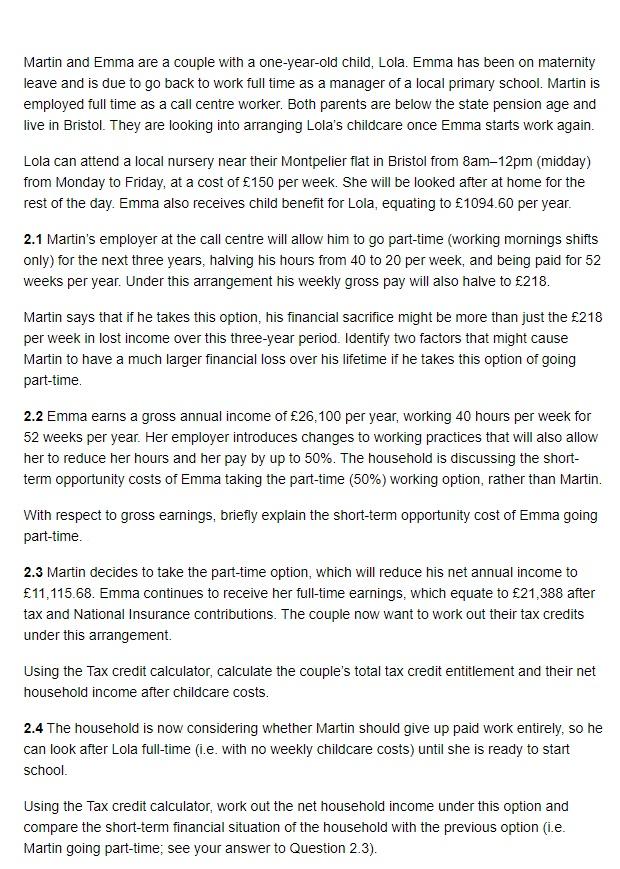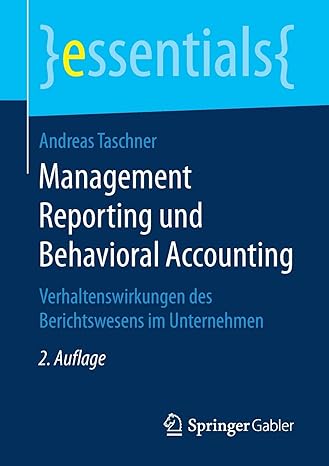
Martin and Emma are a couple with a one-year-old child, Lola. Emma has been on maternity leave and is due to go back to work full time as a manager of a local primary school. Martin is employed full time as a call centre worker. Both parents are below the state pension age and live in Bristol. They are looking into arranging Lola's childcare once Emma starts work again. Lola can attend a local nursery near their Montpelier flat in Bristol from 8am-12pm (midday) from Monday to Friday, at a cost of 150 per week. She will be looked after at home for the rest of the day. Emma also receives child benefit for Lola, equating to 1094.60 per year. 2.1 Martin's employer at the call centre will allow him to go part-time (working mornings shifts only) for the next three years, halving his hours from 40 to 20 per week, and being paid for 52 weeks per year. Under this arrangement his weekly gross pay will also have to 218. Martin says that if he takes this option, his financial sacrifice might be more than just the 218 per week in lost income over this three-year period. Identify two factors that might cause Martin to have a much larger financial loss over his lifetime if he takes this option of going part-time 2.2 Emma earns a gross annual income of 26,100 per year, working 40 hours per week for 52 weeks per year. Her employer introduces changes to working practices that will also allow her to reduce her hours and her pay by up to 50%. The household is discussing the short- term opportunity costs of Emma taking the part-time (50%) working option, rather than Martin. With respect to gross earnings, briefly explain the short-term opportunity cost of Emma going part-time. 2.3 Martin decides to take the part-time option, which will reduce his net annual income to 11,115.68. Emma continues to receive her full-time earnings, which equate to 21,388 after tax and National Insurance contributions. The couple now want to work out their tax credits under this arrangement. Using the Tax credit calculator, calculate the couple's total tax credit entitlement and their net household income after childcare costs. 2.4 The household is now considering whether Martin should give up paid work entirely, so he can look after Lola full-time (i.e. with no weekly childcare costs) until she is ready to start school. Using the Tax credit calculator, work out the net household income under this option and compare the short-term financial situation of the household with the previous option (i.e. Martin going part-time; see your answer to Question 2.3). Martin and Emma are a couple with a one-year-old child, Lola. Emma has been on maternity leave and is due to go back to work full time as a manager of a local primary school. Martin is employed full time as a call centre worker. Both parents are below the state pension age and live in Bristol. They are looking into arranging Lola's childcare once Emma starts work again. Lola can attend a local nursery near their Montpelier flat in Bristol from 8am-12pm (midday) from Monday to Friday, at a cost of 150 per week. She will be looked after at home for the rest of the day. Emma also receives child benefit for Lola, equating to 1094.60 per year. 2.1 Martin's employer at the call centre will allow him to go part-time (working mornings shifts only) for the next three years, halving his hours from 40 to 20 per week, and being paid for 52 weeks per year. Under this arrangement his weekly gross pay will also have to 218. Martin says that if he takes this option, his financial sacrifice might be more than just the 218 per week in lost income over this three-year period. Identify two factors that might cause Martin to have a much larger financial loss over his lifetime if he takes this option of going part-time 2.2 Emma earns a gross annual income of 26,100 per year, working 40 hours per week for 52 weeks per year. Her employer introduces changes to working practices that will also allow her to reduce her hours and her pay by up to 50%. The household is discussing the short- term opportunity costs of Emma taking the part-time (50%) working option, rather than Martin. With respect to gross earnings, briefly explain the short-term opportunity cost of Emma going part-time. 2.3 Martin decides to take the part-time option, which will reduce his net annual income to 11,115.68. Emma continues to receive her full-time earnings, which equate to 21,388 after tax and National Insurance contributions. The couple now want to work out their tax credits under this arrangement. Using the Tax credit calculator, calculate the couple's total tax credit entitlement and their net household income after childcare costs. 2.4 The household is now considering whether Martin should give up paid work entirely, so he can look after Lola full-time (i.e. with no weekly childcare costs) until she is ready to start school. Using the Tax credit calculator, work out the net household income under this option and compare the short-term financial situation of the household with the previous option (i.e. Martin going part-time; see your answer to Question 2.3)







